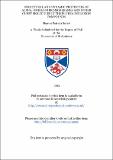Files in this item
Structural and dynamic properties of alpha, omega-dibromoalkanes and other guest molecules in their urea inclusion compounds
Item metadata
| dc.contributor.advisor | Harris, Kenneth | |
| dc.contributor.author | Smart, Sharon Patricia | |
| dc.coverage.spatial | 286 p. | en_US |
| dc.date.accessioned | 2018-07-04T14:52:31Z | |
| dc.date.available | 2018-07-04T14:52:31Z | |
| dc.date.issued | 1993 | |
| dc.identifier.uri | https://hdl.handle.net/10023/14930 | |
| dc.description.abstract | The work described in this thesis focuses on the urea inclusion compounds of α, ω-dibromo-n-alkanes: Br(CH₂)[sub]nBr/urea, where n=7-10. The structural and dynamic properties of the host and guest have been studied using complementary techniques. Photographic single crystal x-ray diffraction shows that, in the regions of three- dimensional guest molecular ordering, there is a well-defined offset, Δg, along the channel axis, c, between guest molecules in adjacent channels. Δg is exactly one-third of the periodic repeat distance along c of the basic guest structure: this represents a new mode of interchannel guest ordering in urea inclusion compounds. Raman spectroscopy shows that the 'bulk' conformation of the guest molecules is the linear, trans, extended form, but that there is a small, but measurable, proportion of Br end-groups in the gauche conformation. Incoherent quasielastic neutron scattering indicates that the guest molecules undergo two motions on the picosecond time-scale, at sufficiently high temperature: translations along the channel axis and reorientations about the channel axis. These motions are successfully modelled as, respectively, continuous linear diffusion between two impermeable boundaries and uniaxial rotational diffusion in a one-fold cosine potential. Deuterium nuclear magnetic resonance spectra are shown, via simulations, to be consistent with a 180° flipping motion of the urea molecules about their C=O axes, occurring on the microsecond time-scale at room temperature. This technique also provides confirmation of guest molecular motion. The structure of 1,6-dibromohexane/urea is found to differ from that of the other a,w-dibromoalkane/urea inclusion compounds studied: crystal structure determination shows that it is monoclinic, and that the host and guest structures are commensurate with one another. Raman spectroscopy confirms that the Br end-groups are exclusively in the gauche conformation. The urea inclusion compounds of various other guest molecules have also been investigated briefly. The complementary nature of the techniques used is crucial in establishing a complete picture of the structure and dynamics of all these compounds. | en_US |
| dc.language.iso | en | en_US |
| dc.publisher | University of St Andrews | |
| dc.subject.lcc | QD305.H6S6 | |
| dc.subject.lcsh | Alkanes | en |
| dc.title | Structural and dynamic properties of alpha, omega-dibromoalkanes and other guest molecules in their urea inclusion compounds | en_US |
| dc.type | Thesis | en_US |
| dc.type.qualificationlevel | Doctoral | en_US |
| dc.type.qualificationname | PhD Doctor of Philosophy | en_US |
| dc.publisher.institution | The University of St Andrews | en_US |
This item appears in the following Collection(s)
Items in the St Andrews Research Repository are protected by copyright, with all rights reserved, unless otherwise indicated.

